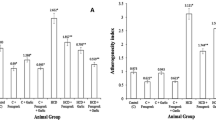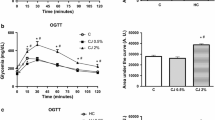Summary
Background
Several lines of evidence indicate that diet rich in fruit and vegetable can protect against cardiovascular diseases by acting on cholesterol metabolism and on oxidative stress.
Aim of the study
The aim of this study was to assess whether daily carrot consumption (provided as lyophilized powder) could differentially influence the consequences of cholesterol supplementation on lipid metabolism and oxidative stress in C57BL/6J mice.
Methods
Fourteen mice were randomized in four groups. Mice were fed either control diets (without or with 0.25% cholesterol added) or lyophilized carrot enriched diets (20% wt/wt without or with 0.25 % cholesterol added) for 4 weeks. Cholesterol and triglycerides in plasma and in liver were measured at the end of the experimental period. Fecal excretion of sterols was evaluated. Vitamin E and carotenoid concentrations were also determined. Several biomarkers relative to oxidative stress such as FRAP (Ferric Reducing Ability of Plasma) and isoprostanes were investigated.
Results
Feeding the carrot diet resulted in a decrease of cholesterol (–41%) and triglycerides (–49 %) in plasma and in the liver (–41% and –39%, respectively) in animals fed cholesterol–supplemented diets. Carrot diet induced an increase of total neutral sterols fecal excretion, which inhibits digestive cholesterol absorption. Carrot diet increased antioxidant status in cholesterolfed mice as related by the 16% higher FRAP values. Although vitamin E was not affected by carrot diet, vitamin E/TG ratio was significantly higher in animals fed carrot diets. The carrot diet induced an increase of vitamin E in the heart in both cholesterol–free and cholesterol–supplemented mice suggesting a higher protection of this tissue.
Conclusion
This study shows that carrot ingestion decreases lipemia and improves antioxidant status in mice. Such results suggest that carrot intake may exert a protective impact against CVD linked to atherosclerosis. It is likely that these effects could be due to the synergistic effect of fiber and associated antioxidants.
Similar content being viewed by others
Abbreviations
- FRAP:
-
Ferric Reducing Ability of Plasma
- TG:
-
triacylglycerol
- LDL:
-
low–density lipoprotein
- VLDL:
-
very low–density lipoprotein
References
Steinmetz KA, Potter JD (1991) Vegetables, fruit, and cancer.I. Epidemiology. Cancer Causes Control 2:325–357
Block G, Patterson B, Subar A (1992) Fruit, vegetables, and cancer prevention: a review of the epidemiological evidence. Nutr Cancer 18:1–29
Ness AR, Powles JW (1997) Fruit and vegetables, and cardiovascular disease: a review. Int J Epidemiol 26:1–13
Gillman MW, Cupples LA, Gagnon D, Posner BM, Ellison RC, Castelli WP, Wolf PA (1995) Protective effect of fruits and vegetables on development of stroke in men. JAMA 273:1113–1117
Alasalvar C, Grigor JM, Zhang D, Quantick PC, Shahidi F (2001) Comparison of volatiles, phenolics, sugars, antioxidant vitamins, and sensory quality of different colored carrot varieties. J Agric Food Chem 49:1410–1416
Robertson J, Brydon WG, Tadesse K, Wenham P, Walls A, Eastwood MA (1979) The effect of raw carrot on serum lipids and colon function. Am J Clin Nutr 32:1889–1892
Jenkins DJ, Kendall CW, Popovich DG, Vidgen E, Mehling CC, Vuksan V, Ransom TP, Rao AV, Rosenberg-Zand R, Tariq N, Corey P, Jones PJ, Raeini M, Story JA, Furumoto EJ, Illingworth DR, Pappu AS, Connelly PW (2001) Effect of a very-high-fiber vegetable, fruit, and nut diet on serum lipids and colonic function. Metabolism 50:494–503
Brown L, Rosner B, Willett WW, Sacks FM (1999) Cholesterol-lowering effects of dietary fiber: a meta-analysis. Am J Clin Nutr 69:30–42
Vahouny GV (1982) Dietary fiber, lipid metabolism, and atherosclerosis. Fed Proc 41:2801–2806
Rémésy C, Demigné C (1974) Determination of volatile fatty acids in plasma after ethanolic extraction. Biochem J 141:85–91
Turley SD, Dietschy JM (1978) Re-evaluation of the 3 alpha-hydroxysteroid dehydrogenase assay for total bile acids in bile. J Lipid Res 19:924–928
Mazur A, Rémésy C, Gueux E, Levrat MA, Demigné C (1990) Effects of diets rich in fermentable carbohydrates on plasma lipoprotein levels and on lipoprotein catabolism in rats. J Nutr 120:1037–1045
Benzie IF, Strain JJ (1996) The ferric reducing ability of plasma (FRAP) as a measure of “antioxidant power”: the FRAP assay. Anal Biochem 239:70–76
Morrow JD, Awad JA, Boss HJ, Blair IA, Roberts LJ 2nd (1992) Non-cyclooxygenase-derived prostanoids (F2-isoprostanes) are formed in situ on phospholipids. Proc Natl Acad Sci USA 89:10721–10725
Feillet-Coudray C, Tourtauchaux R, Niculescu M, Rock E, Tauveron I, Alexandre-Gouabau MC, Rayssiguier Y, Jalenques I, Mazur A (1999) Plasma levels of 8-epiPGF2alpha, an in vivo marker of oxidative stress, are not affected by aging or Alzheimer’s disease. Free Radic Biol Med 27:463–469
Lyan B, Azais-Braesco V, Cardinault N, Tyssandier V, Borel P, Alexandre-Gouabau MC, Grolier P (2001) Simple method for clinical determination of 13 carotenoids in human plasma using an isocratic high-performance liquid chromatographic method. J Chromatogr B Biomed Sci Appl 751:297–303
Tyssandier V, Reboul E, Dumas JF, Bouteloup-Demange C, Armand M, Marcand J, Sallas M, Borel P (2003) Processing of vegetable-borne carotenoids in the human stomach and duodenum. Am J Physiol Gastrointest Liver Physiol 284:G913–923
Mee KA, Gee DL (1997) Apple fiber and gum arabic lowers total and low-density lipoprotein cholesterol levels in men with mild hypercholesterolemia. J Am Diet Assoc 97:422–424
Anderson JW, Hanna TJ (1999) Impact of nondigestible carbohydrates on serum lipoproteins and risk for cardiovascular disease. J Nutr 129:1457S–1466S
Paigen B, Holmes PA, Mitchell D, Albee D (1987) Comparison of atherosclerotic lesions and HDL-lipid levels in male, female, and testosterone-treated female mice from strains C57BL/6, BALB/c, and C3H. Atherosclerosis 64:215–221
Goel V, Cheema SK, Agellon LB, Ooraikul B, Basu TK (1999) Dietary rhubarb (Rheum rhaponticum) stalk fibre stimulates cholesterol 7 alpha-hydroxylase gene expression and bile acid excretion in cholesterol-fed C57BL/6J mice. Br J Nutr 81:65–71
Aprikian O, Levrat-Verny M-A, Besson C, Busserolles J, Rémésy C, Demigné C (2001) Apple favourably affects parameters of cholesterol metabolism and anti-oxidative protection in cholesterol- fed rats. Food Chemistry 75:445–452
Nicolle C, Cardinault N, Aprikian O, Busserolles J, Grolier P, Rock E, Demigné C, Mazur A, Scalbert A, Amouroux P, Rémésy C (2003) Effect of carrot intake on cholesterol metabolism and on antioxidant status in cholesterol- fed rat. Eur J Nutrition 42:254–261
Beynen AC, Klaasen HL, Koopman JP, Fielmich-Bouman AM, Lemmens AG (1989) Liver cholesterol concentrations in mice fed diets containing various sources of fat, carbohydrates or fiber. Int J Vitam Nutr Res 59:401–405
Beynen AC, Meijer GW, Van der Meer R (1988) Comparison of rats with mice concerning the response of lipid metabolism to dietary fats. Z Ernahrungswiss 27:143–149
Elliott J, Mulvihill E, Duncan C, Forsythe R, Kritchevsky D (1981) Effects of tomato pomace and mixed-vegetable pomace on serum and liver cholesterol in rats. J Nutr 111:2203–2211
Goel V, Cheema SK, Agellon LB, Ooraikul B, McBurney MI, Basu TK (1998) In vitro binding of bile salt to rhubarb stalk powder. Nutrition Res 18:893–903
Goel V, Ooraikul B, Basu TK (1997) Cholesterol lowering effects of rhubarb stalk fiber in hypercholesterolemic men. J Am Coll Nutr 16:600–604
Russell DW, Setchell KD (1992) Bile acid biosynthesis. Biochemistry 31:4737–4749
Smith JD (1998) Mouse models of atherosclerosis. Lab Anim Sci 48:573–579
Palozza P, Krinsky NI (1992) Betacarotene and alpha-tocopherol are synergistic antioxidants. Arch Biochem Biophys 297:184–187
Iyama T, Takasuga A, Azuma M (1996) Beta-carotene accumulation in mouse tissues and a protective role against lipid peroxidation. Int J Vitam Nutr Res 66:301–305
Shaish A, Daugherty A, O’Sullivan F, Schonfeld G, Heinecke JW (1995) Betacarotene inhibits atherosclerosis in hypercholesterolemic rabbits. J Clin Invest 96:2075–2082
Shaish A, George J, Gilburd B, Keren P, Levkovitz H, Harats D (1999) Dietary beta-carotene and alpha-tocopherol combination does not inhibit atherogenesis in an ApoE-deficient mouse model. Arterioscler Thromb Vasc Biol 19:1470–1475
Pratico D, Tangirala RK, Rader DJ, Rokach J, FitzGerald GA (1998) Vitamin E suppresses isoprostane generation in vivo and reduces atherosclerosis in ApoE-deficient mice. Nat Med 4:1189–1192
Reeves PG, Nielsen FH, Fahey GC Jr (1993) AIN-93 purified diets for laboratory rodents: final report of the American Institute of Nutrition ad hoc writing committee on the reformulation of the AIN-76A rodent diet. J Nutr 123:1939–1951
AIN-76A (1977) Report of the American Institute of Nutrition ad hoc Committee on Standards for Nutritional Studies. J Nutr 107:1340–1348
Author information
Authors and Affiliations
Corresponding author
Rights and permissions
About this article
Cite this article
Nicolle, C., Gueux, E., Lab, C. et al. Lyophilized carrot ingestion lowers lipemia and beneficially affects cholesterol metabolism in cholesterol–fed C57BL/6J mice. Eur J Nutr 43, 237–245 (2004). https://doi.org/10.1007/s00394-004-0465-3
Received:
Accepted:
Published:
Issue Date:
DOI: https://doi.org/10.1007/s00394-004-0465-3




